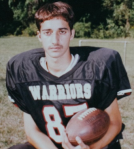“This is a…global tel-link, prepaid call from…Adnan Syed…an inmate at… a Maryland correctional facility. This call will be monitored and recorded…”
That’s the opener for the new NPR podcast program, Serial. One story, told week by week. The series follows a single story, a murder and its aftermath, over an entire season, spooling out the details, piece by piece, in hour-long audio segments.
Here’s the basic plot. In 1999, the body of a young woman named Hae Min Lee was found strangled and buried in a shallow Baltimore grave. Her ex-boyfriend, Adnan Syed, was arrested for the murder, convicted, and sentenced to life plus 30 years for the crime. He has currently served 14 years of his sentence, claiming, as he has from the start, that he is innocent of the crime.
If you haven’t yet listened to Serial. Do. This is good stuff. Excellent, thoughtful, long-form journalism and a fascinating glimpse at what well crafted audio programming can accomplish. First off, Sarah Koenig (an ex-Baltimore Sun reporter and am experienced producer from This American Life), at the helm of this podcast series, is incredibly gifted. She is a solid journalist, a really good interviewer, and a wonderful storyteller. I’ve grown quite fond of her Terri-Gross type interviewing style – compassionate, well spoken, and ever curious about each detail.
Under Koenig’s leadership, the show’s creators do so many things right here – the use of music to build tension and weave connective tissue between episodes, Koenig’s conspiratorial (just you an’ me) voice, the story pace, and the well-placed use of actual recordings (phone conversations, tapes from the two trials, sound effects).
I really like the way that Koenig figures out the story along with you. Nothing is sewn up and tidy, she hands out the evidence, the discoveries, the phone logs, the interviews as she makes her way through them. It’s like you’re on a slow drip, experiencing the story right along with her. Often, as I’m listening, I find myself shouting to my iPhone, “But why didn’t Adnan’s lawyer show that evidence in the trial?!” And sure enough, like she heard me, Koenig will chase that question down. She’s relentless, pouring through evidence, teasing out the truth, talking with everyone remotely connected with the case (which, remember, happened 14 years ago), and expressing her skepticism, her confusion, her fears as she goes. You ride along with her.
The obvious main draw of the serialized story is the ultimate question – is Adnan guilty? Did he do it? Is this guy wrongly convicted and sitting in prison, unjustly, for 13 years? And what of Jay (the prosecution’s chief witness) – is he a liar? Who do we believe? While the whodunnit nature of the show keeps you hooked, it’s also a fascinating procedural vantage point into journalism. How exactly does it work? What do journalists do, what do detectives do when they investigate a crime? And if all of that isn’t interesting enough for you, consider the intriguing challenge of telling this story in an audio-only format (with no visuals). Pretty tall order when you have to track timelines, maps, calendars.
But it’s not just the characters in this true life story that have me gripped, it’s the human elements, put on display so effectively. The people in the story are oh so painfully flawed. They have unreliable memories. They rationalize and tell lies at every turn. They are completely unreliable narrators. How could so many aspects of the story be so confused? What Koenig teases out, time and time again, is that we don’t remember much that would be useful in a criminal trial from an average day. The day that Hae’s life was taken was, in fact, for most of the people in this story, just an incredibly average, oh-so normal day. Because of that, they really can’t remember – did you leave school at 2:15 or 2:30? Did you go to the Best Buy before or after track practice? What time did you place that phone call?
The podcast is extremely successful (1.5 million listeners, and counting). It has its own website (complete with original documents, photos, links), there’s a Reddit thread to follow, reviews in many major papers, and Slate magazine has spawned a podcast (a spoiler special) about the podcast itself (how meta). Recognizing how many people were listening to Serial, hashing it over, debating it, and questioning it Slate decided to bring those follow-on conversations to the air. They post their own interpretive podcast after each Serial episode. It’s a perfect combination to first listen to an episode of Serial, then follow it with the companion Slate spoiler special. It’s like seeing a controversial movie and then sitting down with Siskel and Ebert to hash it over.
I’m up to Episode 6 of Serial now. Four more to go. And they’ve announced they will do a second season – a new story presumably. I can’t wait.
Additional stuff found online since:
Photos of the kids, the high school, maps of the area from the Huffington Post
Stephen Colbert’s interview with producer, Sarah Koenig.
Sarah Koenig interviewed on Fresh Air by Teri Gross.
Funny or Die parody of the last episode.
SNL’s paraody of Serial.




What a great exploration of the fast-changing podcast medium. Predictions are podcasts will not replace radio but be a parallel offering. As with all things Internet, they have yet to settle on a business model, but chances are it will involve advertisement.
Can I agree more, please? The extra bonus for me is that the story takes place in the suburban area of Baltimore where I grew up. Woodlawn was the next high school from mine (Milford Mill, where, ironically, Ira Glass graduated 5 years before more). I worked at Woodlawn Mall, hung out at Security Mall, and Lincoln Park was a place no one I knew went.
The whole idea of how much of the legal system hinges on having a total recall like capability for events that happened in the past to me is the real story. And how many human points of strength and weakness play into the machine.
I am not sure what the relevance of “podcast” is here- the reason it is popular is because it’s well produced audio. This is why in ds106 we use This American Life, Radio Lab, The Truth (“movies for your ears”) as materials to learn audio techniques from. The word “podcast” only refers to the distribution system, not the media, not the genre.
Yet it’s in the name of the show itself I find interest- in these days f Netflix binge watching, Serial goes back to the spacing out of episodes; it builds tension, anticipation. I wonder if that will be taken up?
I hope Neil that advertising is not the only way to produce quality audio shows. Sponsorship (which might be construed as advertising)? Will we see product placements? (yuck). Licensing of material? Would people ever pay for subscriptions to high quality produced shows?
I’m staying tuned (and like you Robin, am only up to episode 5, but have some long drive time ahead…)
Well, what are the chances of that? Boyhowdy, the fact that this serialized story takes place in your old stomping grounds, Alan, adds an extra element of fascination. Cool.
So true about the legal system and its reliance on absolute and precise recall. And isn’t it amazing how many people can be so sure of different truths? We are, indeed, unreliable narrators.
Good point about “podcast” being just the delivery mechanism. What we’re really gobsmacked by here is extremely well produced audio. I’m so impressed by Serial’s producers’ ability to create this vivid story using nothing but sound. (Though I will admit that I craved pictures, maps, and visuals – and went looking for them. But then again, the search for such – on my own – added another dimension to my enjoyment of the experience).
Indeed, they have asked for contributions. The preface to episode 9 includes a request from Sarah Koenig for contributions to keep Serial on the air.
And you are totally right, it’s the serialized nature of the thing – parcing out the story in weekly installments – that adds a new dimension to it all. Isn’t it interesting how these other resources (the Slate companion podcast, for instance) have cropped up to add to the tension and anticipation. A really interesting study.
Thats why you should tas ds106 http://ds106.us/radio-shows/